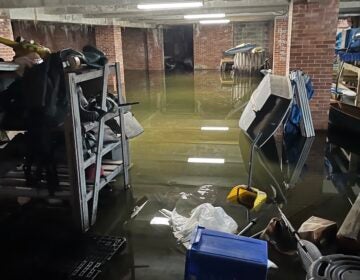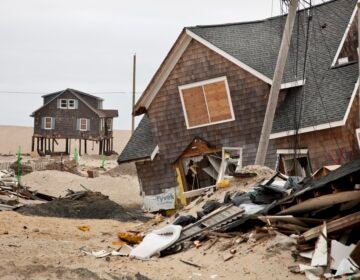Climate scientists say extreme rain behind deadly Bucks County flood is becoming more frequent
The storm behind the deadly Bucks County flood dumped about a month’s worth of rain in two hours. It’s the sort of deluge scientists say climate change could make more common.

A roadblock is seen as crews search for a a pair of missing children swept away after weekend rains, Monday, July 17, 2023, in Washington Crossing, in Upper Makefield Township, Pa. (AP Photo/Matt Slocum)
This story is part of the WHYY News Climate Desk, bringing you news and solutions for our changing region.
From the Poconos to the Jersey Shore to the mouth of the Delaware Bay, what do you want to know about climate change? What would you like us to cover? Get in touch.
The flooding that killed at least five people in Bucks County Saturday came from a storm that dumped roughly a month’s worth of rain in just two hours. The search continues for two young children, a 9-month-old and 2-year-old who were swept away in the flash flood.
It’s a tragic example of the type of deluge that scientists say is becoming more common due to human-caused climate change.
“We’ll be seeing these more frequently as time moves on,” said Jonathan Gourley, a research hydrometeorologist at the NOAA National Severe Storms Laboratory. “What we used to think were very rare events are going to become more common.”
It’s unclear how climate change impacted this particular storm. But climatologists are increasingly developing models to measure the impacts on individual events.
The nearest weather station at Washington Crossing measured 4.48 inches of rain between 4 and 6 p.m. Saturday, said Mike Lee, a meteorologist with the National Weather Service office in Mt. Holly, New Jersey. That’s just below the 4.6 inches a nearby station at the Trenton-Mercer Airport averaged for the whole month of July since 2000.
Radar estimates put rainfall at up to 6 inches Saturday in the hardest-hit areas, Lee said.
“The flooding that happened … was definitely due to localized flooding,” Lee said. “A thunderstorm sat over the area for about 2 hours and just dumped a tremendous amount of rainfall in a very short amount of time.”
Bucks County Fire Chief Tim Brewer said he had never seen anything like it in his 44 years of responding to such incidents. “I thought Hurricane Ida was the benchmark,” Brewer said Sunday, according to the Washington Post. “This is the new benchmark.”
Heavy downpours have become more common and intense across the United States in recent decades, especially in the Northeast. Warmer air can hold more water vapor, so climate change means an increased risk of extreme rain.
“The rain is falling heavier,” said Lauren Casey, a meteorologist with the research nonprofit Climate Central. “It’s falling faster, it’s falling harder, and it’s accumulating more quickly.”
The fast pace of extreme rainfall events makes them more dangerous, Casey said.
“More rain falling faster reduces that time for the National Weather Service to issue flash flood warnings and for people to get out of harm’s way,” Casey said.
The victims of Saturday’s flood did not drive into the floodwaters, officials said. Instead, their vehicles were overwhelmed by fast-moving water.
“This was the meaning of a flash flood,” Upper Makefield Township Fire Chief Tim Brewer said during a press conference Monday afternoon. “The wall of water came to them. They did not go into the water.”
Recent rainfall in the Philadelphia region may have exacerbated the flooding, as Saturday’s rain fell on ground that was already wet.
“[When] the ground is saturated, it can’t accept any more rain,” Lee said. “So any rain that falls down is immediately pushed into the roadways and then eventually into the rivers and streams.”
Saturday’s storm in Bucks County was “at least” a 200-year event, Gourley said.
“It was indeed a rare and intense rainfall event,” he said.
Climate change is not the only thing making flooding worse. Development of surfaces that prevent water from sinking into the ground — like paved roads and roofs — can increase stormwater runoff.
Going forward, better land use planning and engineering could help communities mitigate the dangerous flooding that can come with heavy rain. This could look like soft surfaces that water can sink into, depressed basketball courts that can hold flood waters, or streets that are designed to convey water to a safe place, said Franco Montalto, a professor in the Department of Civil, Architectural, and Environmental Engineering at Drexel University and president of eDesign Dynamics LLC.
“You start to think strategically about how to use the landscape to direct the water into places where it can flood,” Montalto said. “You’re not trying to necessarily prevent the flood. You’re trying to make the flood occur safely.”
Humans can also limit future increases in heavy rain by rapidly reducing greenhouse gas emissions in the coming years.
WHYY is your source for fact-based, in-depth journalism and information. As a nonprofit organization, we rely on financial support from readers like you. Please give today.







